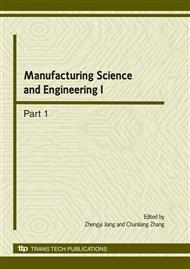p.1186
p.1194
p.1198
p.1203
p.1207
p.1212
p.1216
p.1223
p.1227
Effect of Non-Steady State Loading on Rolling-Sliding Contact Stress
Abstract:
The stresses, strains, and deformations produced by repeated, two-dimensional non-steady state rolling-sliding contact were analyzed using an elastic-plastic finite element model. An advanced cyclic plasticity model was used. The non-steady state rolling contact was restricted to a harmonic variation of the normal Herztian contact pressure. Repeated rolling and sliding were simulated by multiple translations of a set of varying normal and tangential surface tractions across an elastic-plastic semi-infinite half space. The non-steady state loading considered results in a wavy contact surface profile. The surface displacements and wave depth of the wavy deformation increase with increasing rolling passes, but the increases in wave depth per rolling pass (ratchetting rate) decay. The residual stresses and strains near the wave trough of the residual wavy deformation are higher than those near the wave crest. The results are in agreement with the experimental observations. The tangential force has a greater influence on the residual strains than on the residual stresses.
Info:
Periodical:
Pages:
1207-1211
Citation:
Online since:
March 2010
Authors:
Price:
Сopyright:
© 2010 Trans Tech Publications Ltd. All Rights Reserved
Share:
Citation:


